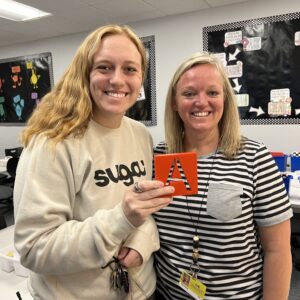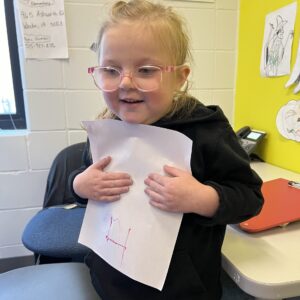3D Printer Creates Learning Tool for Students with Special Needs
A small group of Sugar Creek Elementary teachers are turning to 3D printing technology to support the writing needs of their students with special needs.
Brainstorming a Solution
 “I came up with the idea for a stencil when I was problem-solving with fellow teacher Krissa LeBlanc on how I could help support my student’s writing needs,” Special Education teacher Hannah Platts said. “I was envisioning a stencil that needed to be thick enough so when the students put their pencils or pens in, they wouldn’t slide out.”
“I came up with the idea for a stencil when I was problem-solving with fellow teacher Krissa LeBlanc on how I could help support my student’s writing needs,” Special Education teacher Hannah Platts said. “I was envisioning a stencil that needed to be thick enough so when the students put their pencils or pens in, they wouldn’t slide out.”
Platts says she looked online to find thick alphabet stencils but didn’t find what she needed. She also considered making cardboard stencils but knew those wouldn’t hold up over time. That’s when she and LeBlanc came up with the idea of working with technology teacher Abby Goeller to use the school’s 3D printer to create stencils.
Using 3D Printing
“I was super excited when she came my way with this idea because this is how I envisioned using our printer,” Goeller said. “I want students to come up with ideas that could help another student or teacher in the building, so this fits perfectly. Now, I just need to move this concept to the students dreaming up ideas and my vision will be complete.”
The 3D-printed letter stencils are thicker, making learning letter strokes easier for students like Hazel Ranes and Marcus Kang who need extra visual and fine motor support. Hazel and Marcus recently started testing the “M” and “H” stencils to practice the first letter of their names.
Gaining Independence
 “Independence is the biggest goal. Many students I work with require 1:1 adult support, so the more independence we can create for them, the better!” Platts says.
“Independence is the biggest goal. Many students I work with require 1:1 adult support, so the more independence we can create for them, the better!” Platts says.
The teacher crew is printing alphabet stencils first and then will create 3D numbers stencils. It’s not a quick project — each stencil takes five hours to print.
“Seeing my idea come to life is very exciting and rewarding! We have to be creative with some of our students and think outside the box. This was definitely an out-of-the-box idea!” Platts added.




